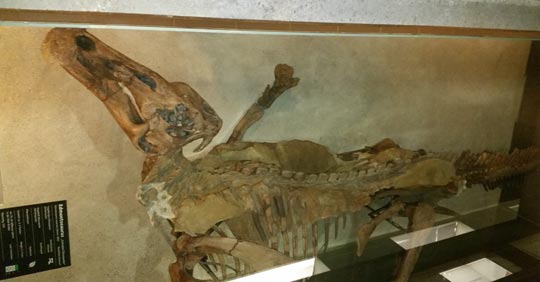Articulated Caudal Vertebrae of a Hadrosaur Uncovered in Alberta
A construction worker excavating using a mechanised digger got a bit of a surprise when his back hoe smashed through a piece of rock revealing a set of dinosaur bones. The worker, a member of a construction crew digging a pipeline on behalf of Tourmaline Oil Corporation, uncovered what appears to be the articulated tail bones of a hadrosaur (duck-billed dinosaur), a member of the ornithischian group of dinosaurs that roamed north-western Alberta around seventy-five million years ago.
Articulated Dinosaur Tail
Although some news reports have claimed that the fossilised caudal vertebrae indicate a reptile more than one hundred feet long, these claims are erroneous, with most palaeontologists, including those from the Royal Tyrrell Museum at Drumheller (Alberta), that were called in to examine and excavate the fossils, estimating an overall body length of around ten metres or so. Work on the pipeline has been halted to permit the scientists to map and examine the site to see if they can find further evidence of this herbivorous dinosaur.
Recently, Everything Dinosaur team members reported the discovery of another hadrosaurid dinosaur articulated vertebrae from Mexico.
To read more about this discovery: The Tale of a Hadrosaur’s Tail.
Alberta is Famous for Dinosaur Fossils
Although, the Canadian province of Alberta is famous for its Late Cretaceous dinosaur fossils, the discovery of articulated caudal vertebrae (tail bones) is an exceptionally rare event. Hopefully other elements of the skeleton will be uncovered, as trying to identify the genus from just the caudal vertebrae may prove to be exceptionally difficult. Post cranial skeleton material, elements such as the caudal vertebrae are relatively uniform in hadrosaur fossils, however, if parts of the skull can be found then a stab at identifying the genus or even the species can be made.
The Fossilised Remains of a Hadrosaur (Edmontosaurus)

The Edmontosaurus exhibit at the Frankfurt Natural History Museum. Picture credit: Everything Dinosaur.
Picture credit: Everything Dinosaur
To view models and replicas of hadrosaurs and other dinosaurs: CollectA Deluxe Prehistoric Animal Figures.
A spokesperson from Everything Dinosaur commented that if other parts of the backbone can be found then the presence of tall spines (neural processes) could indicate that the remains are that of a lambeosaurine hadrosaurid known as Hypacrosaurus, which is known from several specimens excavated from Upper Cretaceous strata of Alberta.





Leave A Comment